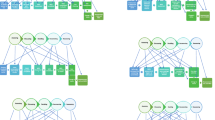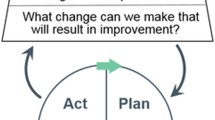Abstract
Behavior analysts visually analyze graphs to interpret data in order to make data-based decisions. Though front-line employees implement behavioral interventions on a daily basis, they are not often trained to interpret these data. A clinical decision-making model may aid front-line employees in learning how to interpret graphs. A multiple-baseline-across-participants design was used to evaluate the effectiveness of a clinical decision-making model on the percentage of correct responses when interpreting line graphs. All of the participants increased their percentage of correct responses after the introduction of the clinical decision-making model. Two of the eight participants required additional feedback. The implications of these findings are discussed.







Similar content being viewed by others
References
Baer, D. M., Wolf, M. M., & Risley, T. R. (1968). Some current dimensions of applied behavior analysis. Journal of Applied Behavior Analysis, 1, 91–97. https://doi.org/10.1901/jaba.1968.1-91.
Behavior Analyst Certification Board. (2016a). Professional and ethical compliance code for behavior analysts. Retrieved July 20, 2019, from http://bacb.com/ethics-code/.
Behavior Analyst Certification Board. (2016b). Registered Behavior Technician™ (RBT ® ) task list. Retrieved April 17, 2017, from http://bacb.com/rbt-task-list/.
Board, Behavior Analyst Certification. (2018). US employment demand for behavior analysts: 2010–2017. Littleton, CO: Author.
Brodhead, M. T. (2015). Maintaining professional relationships in an interdisciplinary setting: Strategies for navigating nonbehavioral treatment recommendations for individuals with autism. Behavior Analysis in Practice, 8(1), 70–78. https://doi.org/10.1007/s40617-015-0042-7.
Brodhead, M. T., Cox, D. J., & Quigley, S. P. (2018). Practical ethics for effective treatment of autism spectrum disorder. New York, NY: Academic Press.
Deochand, N., & Fuqua, R. W. (2016). BACB certification trends: State of the states (1999 to 2014). Behavior Analysis in Practice, 9, 243–252.
Fisher, W. W., Kelley, M. E., & Lomas, J. E. (2003). Visual aids and structured criteria for improving visual inspection and interpretation of single-case designs. Journal of Applied Behavior Analysis, 36, 387–406. https://doi.org/10.1901/jaba.2003.36-387.
Fiske, K., & Delmolino, L. (2012). Use of discontinuous methods of data collection in behavioral intervention: Guidelines for practitioners. Behavior Analysis in Practice, 5, 77–81.
Geiger, K. A., Carr, J. E., & LeBlanc, L. A. (2010). Function-based treatments for escape-maintained problem behavior: A treatment selection model for practicing behavior analysts. Behavior Analysis in Practice, 3(1), 22–32.
Green, G. (2010). Training practitioners to evaluate evidence about interventions. European Journal of Behavior Analysis, 11, 223–228. https://doi.org/10.1080/15021149.2010.11434346.
Grow, L. L., Carr, J. E., & LeBlanc, L. A. (2009). Treatments for attention-maintain problem behavior: Empirical support and clinical recommendations. Journal of Evidence-Based Practices for Schools, 10, 70–92.
Higbee, T. S., Aporta, A. P., Resenda, M. N., Goyos, C., & Pollard, J. S. (2016). Interactive computer training to teach discrete-trial instruction to undergraduates and special educators in Brazil: A replication and extension. Journal of Applied Behavior Analysis, 49, 780–793. https://doi.org/10.1002/jaba.329.
Hunt, P., Soto, G., Maier, J., & Doering, K. (2003). Collaborative teaming to support students at risk and students with severe disabilities in general education classrooms. Exceptional Children, 69, 315–332.
Kelly, A., & Tincani, M. (2013). Collaborative training and practice among applied behavior analysts who support individuals with autism spectrum disorder. Education and Training in Autism and Developmental Disabilities, 48, 120–131.
Leaf, J. B., Leaf, R., McEachin, J., Taubman, M., Smith, T., Harris, S. L., et al. (2016). Concerns about the Registered Behavior Technician™ in relation to effective autism intervention. Behavior Analysis in Practice, 10(2), 157–163. https://doi.org/10.1007/s40617-016-0145-9.
LeBlanc, L. A., Gravina, N., & Carr, J. E. (2009). Training issues unique to autism spectrum disorder. In J. L. Maston (Ed.), Applied behavior analysis for children with autism spectrum disorders (pp. 225–235). Auburn, AL: Springer. https://doi.org/10.1007/978-1-4419-0088-3_13.
Maffei-Almodovar, L., Feliciano, G., Fienup, D. M., & Sturmey, P. (2017). The use of behavioral skills training to teach graph analysis to community based teachers. Behavior Analysis in Practice. https://doi.org/10.1007/s40617-017-0199-3.
Nelson, P. M., Van Norman, E. R., & Christ, T. J. (2016). Visual analysis among novices: Training and trend lines as graphic aids. Contemporary School Psychology, 21, 92–102. https://doi.org/10.1007/s40688-016-0107-9.
Pollard, J. S., Higbee, T. S., Akers, J. S., & Brodhead, M. T. (2014). An evaluation of interactive computer training to teach instructors to implement discrete trials with children with autism. Journal of Applied Behavior Analysis, 47, 765–776. https://doi.org/10.1002/jaba.152.
Sellers, T. P., Alai-Rosales, S., & MacDonald, R. P. F. (2016). Taking full responsibility: The ethics of supervision in behavior analytic practice. Behavior Analysis in Practice, 9, 299–308. https://doi.org/10.1007/s4617-016-0144-x.
Sidman, M. (1960). Tactics of scientific-research: Evaluating experimental data in psychology. New York, NY: Basic Books.
Stewart, K. K., Carr, J. E., Brandt, C. W., & McHenry, M. M. (2007). An evaluation of the conservation dual-criterion method for teaching university students to visually inspect AB-design graphs. Journal of Applied Behavior Analysis, 40, 713–718. https://doi.org/10.1901/jaba.2007.713-718.
Wolfe, K., & Slocum, T. A. (2015). A comparison of two approaches to training visual analysis of AB graphs. Journal of Applied Behavior Analysis, 48, 472–477. https://doi.org/10.1002/jaba.212.
Young, N. D., & Daly, E. J. (2016). An evaluation of prompting and reinforcement for training visual analysis skills. Journal of Behavioral Education, 25, 95–119. https://doi.org/10.1007/s10864-015-9234-z.
Acknowledgements
The authors thank the Early Learning Institute for its support in conducting this study.
Author information
Authors and Affiliations
Contributions
This project was completed in partial fulfillment of a Masters in Applied Behavior Analysis Degree by the first author, under the supervision of the second author.
Corresponding author
Ethics declarations
Conflict of interest
The authors declare that they have no conflict of interest.
Human and Animal Rights
All procedures performed in studies involving human participants were in accordance with the ethical standards of the institutional and/or national research committee and with the 1964 Helsinki Declaration and its later amendments or comparable ethical standards.
Informed Consent
Informed consent was obtained from all individual participants included in the study.
Additional information
Publisher's Note
Springer Nature remains neutral with regard to jurisdictional claims in published maps and institutional affiliations.
Rights and permissions
About this article
Cite this article
Kipfmiller, K.J., Brodhead, M.T., Wolfe, K. et al. Training Front-Line Employees to Conduct Visual Analysis Using a Clinical Decision-Making Model. J Behav Educ 28, 301–322 (2019). https://doi.org/10.1007/s10864-018-09318-1
Published:
Issue Date:
DOI: https://doi.org/10.1007/s10864-018-09318-1




